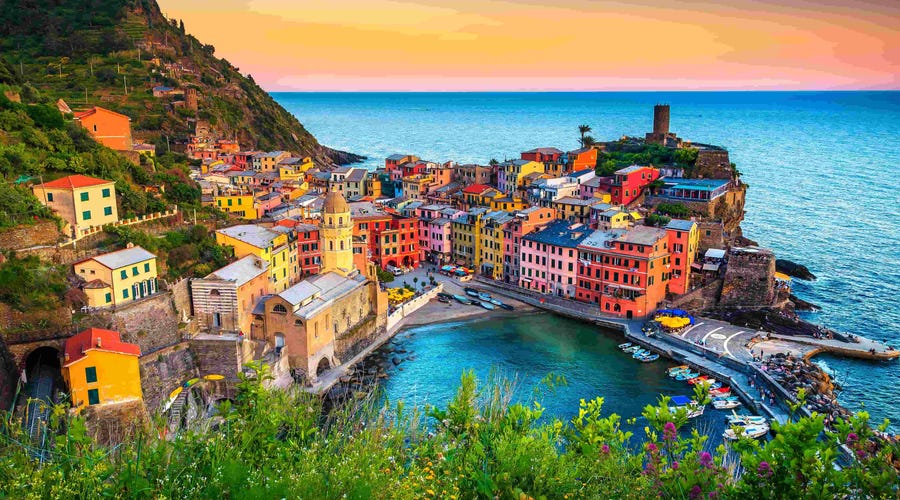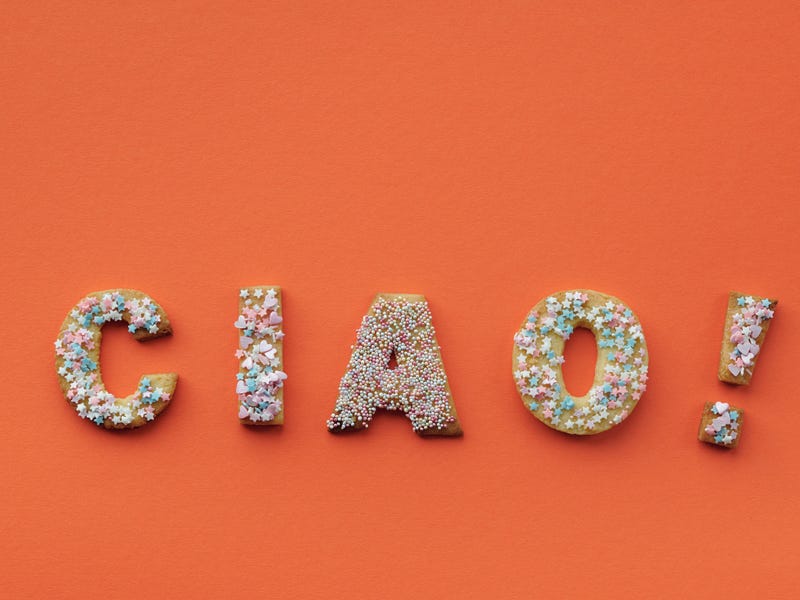
99 delightful shades of color in Italian, from mint to mulberry
Author: Marta Fava
Whether you want to describe the colors of a beautiful fall afternoon on the hills of Tuscany, or make sure the gelataio scoops the right flavor onto your cone during your Italian holidays, learning the names of the colors in Italian is a delightful skill to have!
In this exhaustive guide to the Italian colors, you’ll not only learn all the different sfumature (shades) of each of the main colors, but also how to pronounce them use them in a sentence.
In the tables below, you’ll find a visual representation of the colors, their Italian names with their translation and a phonetic transcription specially created to help English speakers get the Italian pronunciation just right.
Let’s start!
Download our free paper chatterbox to help you learn Italian colors in no time!
Table of contents
- Why learn all the colors in Italian?
- Colors in Italian
- Free downloadable paper chatterbox
- Songs in Italian color
- Italian colors FAQs
- A few colorful tips
- Expressions with colors in Italian
Why learn all the colors in Italian?
If your love for this beautiful language isn’t enough of a reason, here’s why you should learn to express yourself in Italian color.
Travelling in Italy
If you’re planning a trip to Italy, adding Italian colors to your vocabulary is a magnificent idea. Having a wide vocabulary foundation is one of the most important aspects of learning a language and navigating everyday life in another country.
You’ll be able to better understand directions (for example, metro lines are often defined by a color), do better shopping (if you’re a fashion enthusiast, Italy is great!) and just generally describe any object to Italian speakers.
Plus, the tables for “red in Italian” and “yellow in Italian” will be invaluable if you like to attend wine tastings!
Understanding expressions and proverbs
There are many idioms and informal expressions that include the names of colors in Italian. Knowing them will surely help you recognize them and start using them too. If you want a list of the most common ones, we got you covered, read on!
Appreciating Italian art
Italy is famous all over the world for its art, and it is a well-deserved fame. Anywhere you go, from the smallest mountain village to seaside towns, you’ll find frescos, statues, and paintings by famous artists.
If you love art, then understanding the Italian descriptions of these works of art will bring you great satisfaction. Learning the many shades in Italian is undoubtedly a great start!
Colors in Italian
Let’s get started then. First of all, how do you say “color” in Italian? Here the “just add a vowel at the end if you don’t know a word” rule works: il colore (eel coh-loh-reh) is the singular and i colori (ee coh-loh-ree) the plural.
Colors can be nouns or adjectives.
| Italian | English |
| Il rosso è il mio colore preferito. | Red is my favourite color. |
| Il libro rosso è mio. | The red book is mine. |
When they are adjectives, like in the second example, they go after the object they describe.
To add a description of the color, for example, if it is light or dark, you can add chiaro (light) and scuro (dark) after the color.
| Italian | English |
| Il quaderno verde chiaro è di Giacomo. | The light green book is Giacomo’s. |
| Ho un cappello blu scuro. | I have a dark blue hat. |
If, on the other hand, you want to ask what color something is, use:
- Di che colore è … ?
- Di che colore sono … ?
With some of the specific names of colors that you’ll find in the table, you’ll need to use the expression: “color ___”
| Italian | English |
| La sciarpa è color lavanda. | The scarf is lavender. |
Colors can also take diminutives, this usually makes them “lighter”: Il pigiama giallino (the light yellow pyjamas).
Purple in Italian
Purple in Italian is viola. This is not only the name of a color – a viola or violetta is also a flower!
| Italian | English |
| Le viole fioriscono dall’autunno alla primavera. | Violets flower from fall to spring. |
And it doesn’t end there. Viola or Violetta in Italian is also a girl’s name.
| Italian | English |
| Mia figlia si chiama Viola. | My daughter’s name is Viola. |
So from fruits to flowers, we’ve got you covered for some wonderful shades of purple.

| English | Italian | Pronunciation |
|---|---|---|
| Lavender | lavanda | lah-vaan-dah |
| Purple | viola | vee-oh-lah |
| Violet | violetto | vee-oh-let-toh |
| Grape | uva | ooh-vah |
| Mauve | malva | maal-vah |
| Mulberry | mora | moh-rah |
| Plum | prugna | prooh-nya |
| Lilac | lilla | leel-lah |
| Indigo | indaco | een-dah-coh |
Remember to keep in mind that Viola does not change its ending according to the subject described, like some colors do. It always stays the same.
Orange in Italian
Orange in Italian is arancione which is also sometimes called arancio (like an orange tree!). Careful, though, the fruit is feminine: arancia.

| English | Italian | Pronunciation |
|---|---|---|
| Tangerine | mandarino | maan-dah-ree-noh |
| Orange | arancione | ah-raan-choh-neh |
| Amber | ambra | ahm-brah |
| Bronze | bronzo | brohn-dzoh |
| Burnt Orange | rosso aragosta | roh-ssoh ah-rah-goh-stah |
| Marmalade | arancio scuro | ah-raan-choh scoo-roh |
| Mango | mango | maan-goh |
| Rust | ruggine | roo-jee-neh |
| Papaya | papaya | paa-paa-yah |
Again, Arancione does not change its ending according to the subject described, like some colors do. It always stays the same.
Blue in Italian
There are two main ways of saying blue in Italian: blu and azzurro. The first describes a darker color, while azzurro is usually light blue.

| English | Italian | Pronunciation |
|---|---|---|
| Royal Blue | blu reale | blooh reh-ah-leh |
| Blue | blu | blooh |
| Turquoise | turchese | toor-keh-seh |
| Teal | tè blu | blooh |
| Cyan | ciano | chah-noh |
| Sky Blue | azzurro | ah-dzur-roh |
| Navy Blue | blu marino | blooh mah-ree-noh |
| Baby Blue | celeste | cheh-less-teh |
| Midnight Blue | blu notte | blooh noh-tteh |
- Similarly, Blu does not change its ending according to the subject described like other colors do. It always stays the same.
- Azzurro, on the other hand, does.
Red in Italian
If you want to be able to order a good bottle of wine, you need to know how to say red in Italian… Rosso!
Red in Italian is one of the colors that change their ending according to what they describe, like a typical adjective.

| English | Italian | Pronunciation |
| Burgundy | bordeaux | bohr-doh |
| Red | rosso | ross-soh |
| Cherry | rosso ciliegia | ross-soh chee-lyeh-jah |
| Crimson | cremisi | creh-mee-seeh |
| Brick Red | rosso mattone | ross-soh maatt-oh-neh |
| Blood Red | rosso sangue | ross-soh saan-gweh |
| Maroon | granata | grah-nah-tah |
| Berry | rosso scuro | ross-soh scoo-roh |
| Scarlet | scarlatto | scaar-laat-toh |
Yellow in Italian
Giallo is “yellow” in Italian. This color is also used to talk about thriller/crime books or films:
| Italian | English |
| Sto leggendo un giallo. | I am reading a crime novel. |
Giallo changes its ending according to what you’re describing: giallo, gialla, gialli, gialle.

| English | Italian | Pronunciation |
|---|---|---|
| Lemon | limone | lee-moh-neh |
| Yellow | giallo | jaal-loh |
| Cream | crema | creh-mah |
| Canary | canarino | cah-nah-ree-noh |
| Chartreuse | chartreuse | shar-treus |
| Gold | oro | oh-roh |
| Light Yellow | giallo chiaro | jaal-loh kyah-roh |
| Sand | sabbia | saab-byah |
| Mustard | senape | seh-nah-peh |
Brown in Italian
To describe something brown in Italian, you need to use the word marrone, or marron. This is also a word to say “chestnut”, the actual fruit.
If you’re talking about someone’s brown hair or eyes, however, we prefer to use capelli/occhi castani.

| English | Italian | Pronunciation |
|---|---|---|
| Caramel | caramello | cah-rah-mell-loh |
| Brown | marrone | maar-roh-neh |
| Sepia | seppia | sehp-pyah |
| Chestnut | marrone castagna | maar-roh-neh cass-tah-nyah |
| Chocolate | cioccolato | choc-coh-lah-toh |
| Almond | mandorla | maan-dorr-lah |
| Cedar | marrone scuro | maar-roh-neh scoo-roh |
| Coffee | caffè | caaf-fèh |
| Walnut | noce | noh-cheh |
Remember that Marrone does not change its ending according to the subject described, like other colors do. It always stays the same.
Pink in Italian
Rosa, which is “pink” in Italian, also is a flower… Guess which? Yes, of course, it’s the word for “Rose”. It’s also a girl’s name.

| English | Italian | Pronunciation |
|---|---|---|
| Peach | pesca | pehs-kah |
| Pink | rosa | roh-zah |
| Coral | corallo | coh-rall-loh |
| Rouge | rouge | rooj |
| Magenta | magenta | mah-gen-tah |
| Salmon | salmone | saal-moh-neh |
| Blush | rosa chiaro | roh-zah kya-roh |
| Hot Pink | fucsia | fook-syah |
| Strawberry | rosso fragola | ross-soh kya-roh |
Rosa does not change its ending according to the subject described like other colors do. It always stays the same.
Green in Italian
Green in Italian is verde. Read on if you want to learn all the idiomatic expressions you can use with the color of the forest!

| English | Italian | Pronunciation |
|---|---|---|
| Sage | salvia | saal-vyah |
| Green | verde | verr-deh |
| Jade | giada | jaah-daah |
| Seafoam | Verde acqua | verr-deh ah-kwah |
| Lime | lime | lah-eem |
| Forest | verde mimetico | verr-deh mee-meh-tee-koh |
| Olive | verde oliva | verr-deh oh-lee-vah |
| Emerald | smeraldo | smeh-rall-doh |
| Mint | menta | men-tah |
Verde does not change its ending according to the subject described like other colors do. It always stays the same.
Black in Italian
Nero is the Italian for “black”. It changes its ending according to the gender and number of what it describes.

| English | Italian | Pronunciation |
|---|---|---|
| Ebony | ebano | eh-bah-noh |
| Black | nero | neh-roh |
| Cool black | nero notte | neh-roh noht-teh |
| Ink | inchiostro | een-kyoh-stroh |
| Obsidian | ossidiana | oss-see-dyah-nah |
| Jet black | nero corvino | neh-roh corr-vee-noh |
| Charcoal | carbone | caar-boh-neh |
| Onyx | onice | oh-nee-cheh |
| Midnight | nero mezzanotte | Neh-roh medz-zah-noht-teh |
White in Italian
White in Italian is bianco. This describes white wine (vino bianco) and, in its feminine singular form Bianca (yes, it changes according to gender and number, becoming bianca, bianchi, bianche) is also a girl’s name.
For example, Biancaneve (Snow White!)

| English | Color in Italian | Pronunciation |
|---|---|---|
| Beige | Beige | behj |
| White | bianco | bee-ann-coh |
| Ivory | avorio | ah-voh-ryoh |
| Eggshell | guscio d’uovo | goo-shoh doo-oh-voh |
| Coconut | cocco | cock-oh |
| Pearl | perla | perr-lah |
| Bone | osso | oss-soh |
| Alabaster | alabastro | ah-lah-bass-troh |
| Off white | bianco sporco | bee-ahnn-coh sporr-koh |
Free downloadable paper chatterbox
This fun paper chatterbox will help you learn Italian colors in no time! Our aim is to use both visualization and spelling techniques to help you remember the color names. Folding instructions are included on the pdf.
Songs in Italian color
Ma il cielo è sempre più blu
This song by Rino Gaetano will surely put you in a good mood, and the lyrics are clear, so it’s great practice, and not only for revising the colors in Italian: “Il cielo è sempre più blu!”
Franco Battiato - Cuccurucucu
Do you think the world is gray or blue? This song from the great Franco Battiato is an Italian classic, you can’t miss it!
I Colori - Canzoni di Nuovi Sogni
If you want to hear the pronunciation of all colors and don’t mind children songs, then listen to this on how to make secondary colors…
Italian colors FAQs
Is colors in Italian masculine or feminine?
Even when they finish is “a”, like in rosa (pink) and viola (purple), colors in Italian are always masculine: il rosso (red), il viola (purple), il verde (green).
Colors that end in “o”, if used as adjectives, take the gender and number of the thing they describe:
| Italian | English |
|---|---|
| Una giacca rossa | A red jacket |
| Delle case bianche | Some white houses |
| Dei gatti neri | Some black cats |
Are colors capitalized in Italian?
No, colors are never capitalized in Italian. Unless, of course, they are used as a proper name, like in the case of Bianca or Viola.
How do you say “gray” in Italian?
We learned how to say nero and bianco, but of course, things are not always black and white. Let’s not forget about grigio (gray).
Gray in Italian also changes according to the gender and number of what it describes: grigio, grigia, grigi, grigie.
Here’s a table with some types of grigio:
| English | Italian | Pronunciation |
|---|---|---|
| Pearl gray | grigio perla | gree-joh pehrr-lah |
| Gray | grigio | gree-joh |
| Charcoal gray | grigio antracite | gree-joh ann-trah-chee-teh |
| Slate | ardesia | arr-deh-zyah |
| Silver | argento | arr-jen-toh |
| Platinum | platino | plaah-tee-noh |
| Dove gray | tortora | torr-toh-rah |
| Iron gray | grigio ferro | gree-joh fehr-roh |
| Steel gray | acciaio | ah-chah-yoh |
What are the colors of the rainbow (arcobaleno) in Italian?
The colors of the arcobaleno in Italian are:
- rosso (red)
- arancione (orange)
- giallo (yellow)
- verde (green)
- blu (blue)
- indaco (indigo)
- violetto (violet)
How do you say color-blind in Italian?
Color-blind in Italian is daltonico.
A few colorful tips
Now that we’ve looked at all the colors in Italian, you just need to start practicing so that you memorize them! Let’s look at some tips to make it more easy and fun!
1. Play table games!
Playing table games, or Twister, in Italian can be a fun way of memorizing the Italian colors. Many games are color based, and repetition is always a language learner’s best friend!
2. Read about art
If you’re passionate about art, reading art magazines or watching art-related videos can be a great way of revising the colors!
3. Online shopping in Italian
Another great way of keeping up with the colors in Italian is to shop online for new clothes… On Italian websites! Here you’ll learn Italian sizes, the names of Italian clothes and, of course, the colors in Italian!
Expressions with colors in Italian
As we mentioned above, Italian speakers use a lot of slang, expressions and idioms that contain colors. Here are some of the most popular ones, with their literal translation and the actual meaning.
| Italian expression | Literal translation | Meaning in English |
|---|---|---|
| Essere al verde | To be in green | To be broke / have no money |
| Essere verde d’invidia | To be green with envy | To feel a lot of envy |
| Avere il pollice verde | To have a green thumb | To be good at gardening |
| Essere (incavolato) nero | To be (angry) black | To be very angry |
| Vedere tutto grigio / nero | To see everything gray/black | To be very pessimistic |
| A luci rosse | With red lights | Erotic or pornographic |
| Diventare / essere rosso dalla vergogna | To become/be red with shame | To blush |
| Di punto in bianco | From point to white | All of a sudden |
| Settimana bianca | White week | A skiing holiday |
| Passare una notte in bianco | To pass a white night | Not to sleep al night |
| Un assegno in bianco | A check in white | A check that isn’t actually covered |
| Mettere nero su bianco | To put black onto white | To write down clearly |
| Cronaca rosa / Cronaca nera | Pink / black tabloids | Gossip news / crime news |
| Avere il sangue blu | To have blue blood | To be royal |
| Dirne di tutti i colori | To speak all colors | To express anger in words |
All the colors, nero su bianco
So, we’ve put all the colors nero su bianco in this article. Remember, practice is your best friend when you’re learning a foreign language, and the more pleasant and fun you make it to study, the faster you’ll make progress!
Now, go out and describe a beautiful sunset, the color of the sky and sea, nature and animals in Italian to a friend, with all the majestic colors you need!
If you loved this article, discover more Italian vocabulary blog lessons here.



